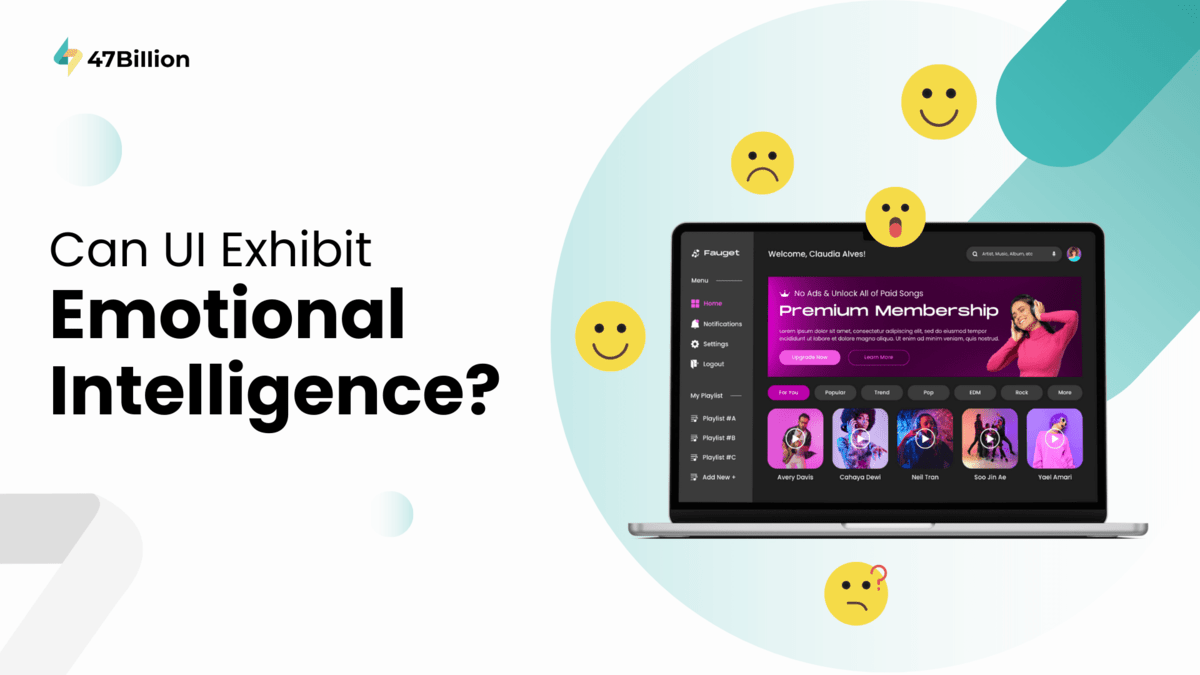Table of Contents
- Can a User Interface Exhibit Emotional Intelligence?
- Let’s now understand PET Designs
- Leveraging psychological principles to persuade
- Conclusion – Delivering a compelling experience
Can a User Interface Exhibit Emotional Intelligence?
Let’s discuss –
This may interest you that about 95% of purchase decisions are made subconsciously based on how customers feel, and therefore eliciting a positive emotion in your customers through frictionless product UX is directly linked to the revenue of your business.
A survey conducted by Bain and Company revealed that around 80% of CEOs believe that their digital products offer a good experience, but unfortunately, only 8% were successful.
And that’s because conventional feedback methods like polls, surveys, and focus groups hardly have insights about the emotions of their prospects. But how does one capture emotional insights from customers?
This can be done in three steps –
- Collect market research and customer insight data to develop qualitative descriptions of what motivates their customers.
- Analyze their loyal customers’ behavioral patterns to learn their motivators and will add high value to your product.
- Then, identify two to three primary key motivators strongly associated with their organization.
This guides the emotions they must connect with to grow their most valuable customer segment. Companies can make the organization’s commitment to emotional intelligence a key lever for growth across all the functional elements of the company.
The Core Motivators

It is critical to optimize emotional connection across all the touchpoints, from product development and marketing to sales and then service. Major investment areas are stores, online and omnichannel experiences, merchandising, and message targeting.
Taking the example of Apple, the brand has positioned itself as a “Think Different” Approach and has developed a brand identity based on it.
The aesthetically beautiful products created have enabled the brand to be associated with luxury in the eyes of its followers. Consumers are always ready to pay a premium for Apple products driven by emotions-based marketing rather than the product’s value. Most product ads you won’t see that talk about features or technicalities; they curate ads to convince audiences that it is the ultimate tool for your life. They sell their product by utilizing feelings that direct towards the idea of owning it. An example is the iPad Air ad, which shows a pencil on a table with different surroundings until they pull up iPad Air.

Let’s now understand PET Designs – Designing for Persuasion, Emotion, and Trust
This is bringing transformation in User Experience and Design methodology. This next loop is all about persuasion, emotion, and trust. You need good usability, but it is not sufficient to design a website that is easy to understand, navigate and interact with. The purpose is to motivate and persuade users to make decisions that lead to conversions.
The design has to be based on social psychology and should be pioneered by Human Factors. It complements traditional usability and user experience best practices. It is all about understanding the emotions that influence user behavior.
persuasive design applies psychological principles of creating an influence, decision-making in a consumer context, engagement strategy, and social psychology to every stage of the design process. It helps identify potential barriers and emotional triggers to elicit the desired actions.
Today UX professionals tend to think of persuasion in design solely in the context of B2C sites. Still, the concept applies to all products and services intended to get affected by human behavioral changes.
Making a decision is an act influenced by both emotions and rationality.
But how can design be altered to capture something as elusive as emotion while keeping it consistent and intuitive?
Can people recognize the emotions they are experiencing and articulate what is influencing them at a particular moment? Can this be done accurately?
Leveraging psychological principles to persuade
The barriers and triggers to desired user behaviors will vary depending on the business objectives and customer characteristics/personas. Any of the six universal principles of social influence can act as a catalyst to trigger an emotional response.
- Reciprocation: Feeling obliged to return favors.
- Authority: Seeking experts.
- Commitment/Consistency: Acting consistently with commitments and values.
- Scarcity: Increasing demand when the resource is less available
- Liking: Accepting offers from people of the same group
- Social Proof: Asking others to guide the path
In addition to principles of social influence, there are psychological principles designers can leverage to increase engagement and help make informed choices. As shown in the below image –

The psychological principles of social influence include the following –
- Completeness: By nature, feeling the need to remove gaps.
- Positive Reinforcement: Letting customers know when they can be kept engaged.
- Loss Aversion: People prefer to keep things private once they have them, thus providing alerts to customers when they are losing engagement.
- Saving for later: A study shows that people commit to spending money in the future rather than today.
- The power of free: Users are prone to choose for free things.
- Susceptible Moments: Opportunities to cross and upsell should be timely so that they are delivered at the point at which people are most receptive.
Take an example of an intranet enabling employees to manage their employer’s package benefits. The range of benefits may vary enormously, from pensions to subsidized magazine subscriptions. The objective is to provide content to support and increase staff engagement as they manage their benefits while reducing demand for help desk resources by assisting staff to make informed choices.
To support these objectives, an intranet should be easy to use and provide the content required to support any behavioral change. Users should see the benefit and have the information they need to make decisions confidently to support management’s objectives for employees to utilize their benefits entirely.
Similarly, Airbnb design imbues customers with trustworthiness, as the below image indicates –

Conclusion – Delivering a compelling experience
Persuasive design allows brands to deliver more than just a digital product. Interactive flows can help build customer loyalty and expand additional revenue streams.
The essence of emotional intelligence (EI) is to identify and manage your and others’ emotions too. User experience and design can benefit from this approach. By recognizing and understanding the behavioral pattern, we can improve our ability to relate to customers, win sales and garner repeat business with improved engagement.
Taking this reasoning one logical step further, is it possible to make User Interfaces emotionally intelligent in the era of Artificial Intelligence tools used for designing?
Stay updated with our next series of blogs – 47billion.com/blogs




